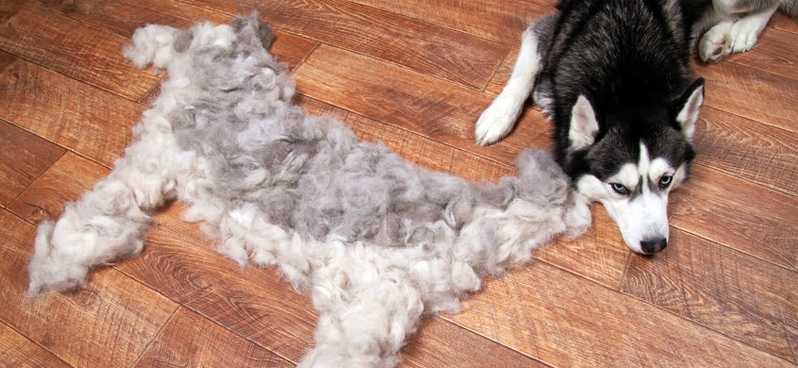Husky Shedding – How To Deal With It Starting Today

The thick, plush fur of Siberian Huskies comes with two perks. First, it protects them from freezing-cold weather. Second, it is eye-candy for both the owners and passers-by alike.
However, if you own a husky, you know well that there is a price to pay. The price is, of course — shedding. As many owners can already tell you, husky shedding is one of their biggest concerns.
You may be wondering how you should deal with this nuisance. Well, we got you covered. But first, let us take a closer look at the fur of a husky and answer the following question:
Why Do Huskies Shed so Much?
As a husky owner, you should know that Siberian Huskies have a double coat of fur. Other such breeds may include German Shepherds, Akitas, Shetland Sheepdogs and Labradors.
This thick coat means huskies need more maintenance than single-coated dogs.
Since huskies need to adapt to changing conditions, they need to shed their fur. This is especially true for climates warmer than their native Siberia.
Typically, they shed in the fall and spring. In the fall, your husky needs to prepare a fluffy winter coat. On the other hand, during springtime, it needs to get rid of that coat and prepare for the summer days.
Other reasons why your husky is shedding so much may be health-related.
If your dog is itchy or develops bald spots, do not hesitate to take it to the vet. A thorough examination will show if there are any underlying illnesses.
The causes may be allergies, nutritional deficiencies, stress or physical pain. Additionally, you may want to consider spaying your female husky. Her heat cycles can also cause uncontrolled shedding.
Finally, check your dog for pesky parasites like fleas, ticks and the like. However, let us hope health is not the issue at hand.
What Can You Do to Control Husky Shedding?

We hate to break it to you, but you cannot prevent your husky from shedding. It is a natural cycle after all.
Do not fear, however, because it can be controlled.
Here are some tools to help you fight this avalanche of fluff:

1) Brushes
For the best results, try using various kinds of brushes for huskies. This will give you more options to choose from. Remember, you want what works best for your dog.
Moreover, you can try brushing them with a human hair brush. Though it may be unconventional, it is worthwhile if it does the trick.
2) Undercoat Rake
An undercoat rake is not only affordable, but it is also the most effective tool according to the majority of husky owners.
It gets deep into the dog’s coat, brushing away the trapped hairs with ease. Moreover, some owners say it is the only tool you need to cope with husky shedding, but we will let you be the judge of that.
3) Vacuum Cleaners and High-Velocity Dryers
After you are finished with the grooming session, make sure to vacuum your dog. According to some owners, Dyson vacuums are perfect for this job.
It is simple — sit your dog on the floor and turn the vacuum on. But as you may know, dogs can get scared by vacuum cleaners. With this in mind, give your dog a treat to help it relax.
A similar tool you can try is the high-velocity dryer. It is almost like a leaf blower but for your dog’s hair.
Since it reduces husky shedding for 2 or 3 weeks, it can be a time-saver. Of course, you may want to take your dog outside if you opt for this method.
What About the Furminator?
There is an ongoing debate on whether this tool is good or not. This rake-type comb with fine teeth has been deemed by some as unsafe.
On the other hand, other owners have achieved good results. A major disadvantage of the Furminator is that it is not an ordinary brush.
In fact, it does not only brush the hairs out-it cuts them. This can leave your pet with a choppy-looking coat.
Also, remember that shedding is a natural process. Accordingly, use tools that help ease the process rather than forcing it.
However, the Furminator is not all that bad when used in moderation:
Other Things to Have in Mind

If brushing your dog gets you too tired to vacuum, consider the iRobot Roomba. This little guy will save you the time and effort. However, it may not work as well on carpets as it does on hard floors.
Final thoughts
Husky fur may look too thick and fluffy for you to handle. However, they are generally considered relatively low-maintenance dogs. Let nature deal with all the hard parts.
Despite that, you should regularly brush your husky and consult a vet if you notice something is wrong.
We hope our advice will keep your husky looking neat, and lessen your troubles caused by husky shedding.

Leave a Comment